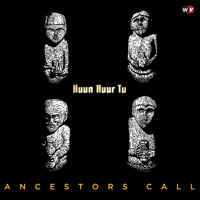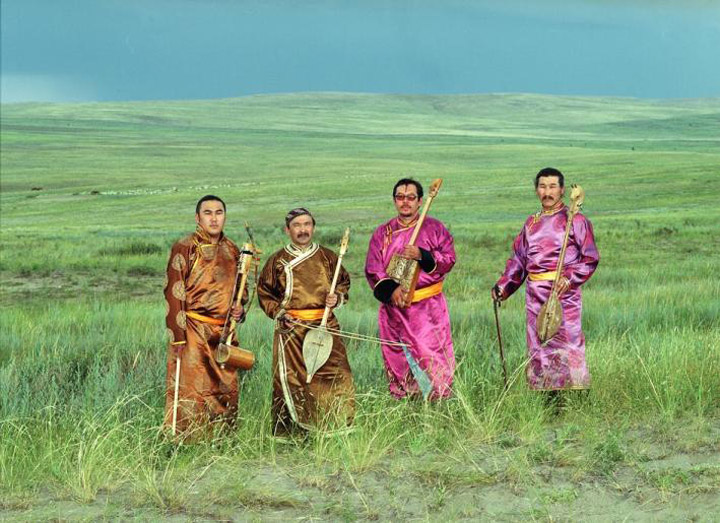Each week, World in Stereo examines classic and modern world music while striving for a greater appreciation of other cultures.
 Huun Huur Tu: Ancestors Call (World Village, 10/12/2010)
Huun Huur Tu: Ancestors Call (World Village, 10/12/2010)
Huun Huur Tu: “Chyraa-Khoor (Yellow Pacer)”
[audio:https://alarm-magazine.com/wp-content/uploads/2010/10/09Chyraa-Khoor-Yellow-Pacer.mp3|titles=Huun Huur Tu: “Chyraa-Khoor (Yellow Pacer)”]
Obtaining music from a tiny, remote place like the Republic of Tuva is similar to possessing some sort of mysterious artifact. For Huun Huur Tu’s latest offering, Ancestors Call, the sentiment holds true as the four folk traditionalists have reintroduced to the world an art form from one of the least-known regions in Siberia. Collecting the group’s most-admired songs, the quartet has redefined the music that it pioneered more than 15 years ago, reworking these original pieces with a 20th Century approach to composition and rhythm.
Recent years have seen the quartet work with artists such as The Kronos Quartet and Ry Cooder, sharing one of the world’s oldest forms of music with a variety of different genres. A close listen to its recent releases proves that the group was positively affected by the collaborations. Ancestors Call does not fall short in innovation as the the doshpuluur (Tuvan form of the lute), igil (two-string bowed instrument that is played upright), and byzaanchi (four-string bowed instrument with a cylindrical sound box) are seen in new light, creating a subtle ambience that recalls Huun Huur Tu’s recent collaboration with electronic producer Carmen Rizzo.
At the core of the group’s music, however, will always be khöömei, or “throat” singing, a style of singing that produces two or three notes at once by amplifying certain harmonics that are naturally present in the voice. By tightening the throat muscles and carefully positioning the lips, tongue, and jaw, throat singers are able to bypass the natural harmonics formed by the vocal cords, resulting in a faint, high-pitched melody that hovers over a low-timbre grumble.
The style is entirely unique to Tuva, dating back centuries with ties to spirituality and a diaphonic technique that shamans used to beckon spirits and summon dead ancestors. But it soon emerged as a way for Tuvans to connect with the earth, a meditation on their insignificance through sounds that mimicked the all-encompassing natural landscape around them. To appreciate the music of Huun Huur Tu in our modern day, it is essential for listeners to understand, geographically, where the music was born.
Along the arbitrary border that separates the south of Siberia and Northwest Mongolia, the Republic of Tuva is in a region characterized by its natural divisions. As its topography spans lowland desert to grassy steppes, the region is a mountain basin encircled by the Tannu-Ola and Sayan ranges, which ultimately give way to hundreds of tributaries that merge to become the Yensai River, one of Siberia’s longest rivers. The land is vast, civilization is sparse, and the pastoral landscape is home for the semi-nomadic Tuvan lifestyle.
Few traditional societies have seen as many changes of authorial rule as Tuva. Its history is complex and, in the end, an intricate weaving of Mongolian, Chinese, and Russian history. The region has been annexed to Russia twice in the span of 30 years: the first in 1914 when it became a protectorate of Russia, and the second in 1944 when the People’s Republic of Tuva was absorbed by the USSR as an autonomous region. But when the USSR fell in 1991, the Tuva Republic was formed as a part of the newly established Russian Federation.
Although the history is extremely confusing, the importance lies in how the indigenous cultures of Tuva have survived such rapid social and political changes. As most Tuvans were illiterate until the beginning of Russian rule, the culture has a rich past of oral folklore. Hence a tradition like throat singing is not to be taken like an instrument in the Western sense but as a way of living, communicating, and being in the world.
Ancestors Call speaks directly to the Tuvan landscape, a musical awakening that lies somewhere between the Mongolian steppes and the thick taiga biomes of the Siberian wood. From the opening vocal overture of “Mazalyk-ta,” it is clear that shamanistic practices still permeate Tuvan music today. By the end of the opening number, Huun Huur Tu successfully achieves a mimetic energy in the combination of voice and instruments, sounding like a descending wind traveling down a snow-peaked mountain.
But perhaps the song that best portrays the art of throat singing comes directly in the middle of the album with “Remembering Ulaatai River,” as lead singer Kaigal-ool Khovalyg demonstrates in this a-cappella track the intuitive ingenuity of the human voice. The harmonic implications and depth of Khovalyg’s sustained melodies are simply amazing. When the near-whistle melodies come into his deep voice, it is a regimented stream in the wilderness that breaks with every rough gasp of breath, only to repeat itself over and over. The song serves as a meditation, an echo of the natural elements.
As the group’s sound has shifted over the years, Huun Huur Tu has come to define a new era in its native folk tradition. For example, “Konguroi,” a track from the group’s 2005 release 60 Horses in My Herd, was a song that had quite a raw quality to it — a simple folk song with just vocals and the Tuvan lute. The same song, however, when revisited on Ancestor Calls, adds a mesmerizing tapestry of string instruments and a hypnotic dimension of layered vocals. The song exemplifies the new-found dimensions that make Huun Huur Tu more relevant to current music sensibilities.
At the same time, the record taps into a universal humanness, a calling for simplicity in the interaction with nature and the ones around us. The group’s members have faced and conquered what many artists struggle with throughout their careers but what runs in the vein of many Tuvan artists of this generation: taking a progressive stance on tradition without sapping its authenticity and originality.

